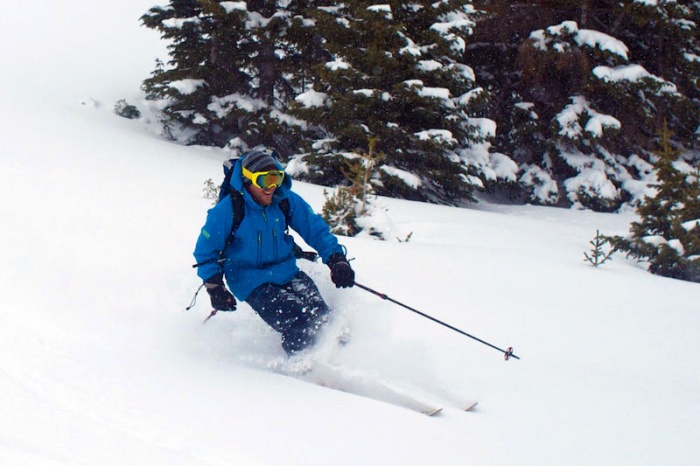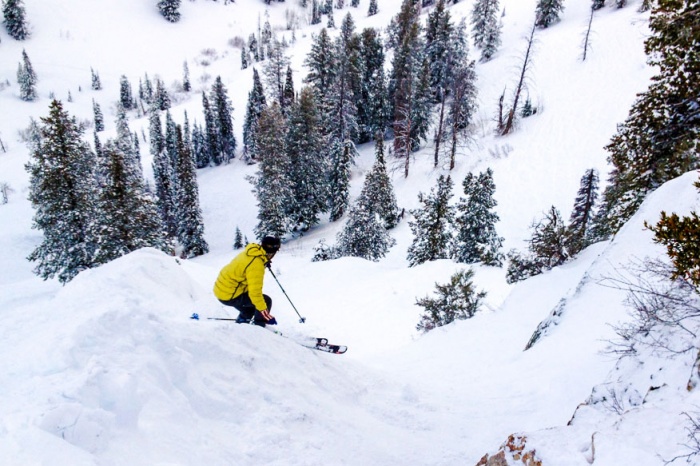Changing snow conditions, weak legs, skiing above your ability: Knee injuries are one of the most common traumas on the slopes. Here are some tips to avoid knee injuries this winter.
It doesn’t take much. A change in snow conditions pushes your skis one way while your body goes the other, the bindings don’t release, and then … “Pop!”
Knee injuries are among the most common ski-related injuries on the slopes. And with rehabilitation taking six weeks or more, they can be a season-killer.
But don’t fret; it’s not too late to get your knees slope ready. Read on to learn more about ski-related knee injuries, along with preventive measures to play it safe on the slopes this winter.
Knee injury: What it is
The knee is a hinge joint, tracking the legs in a forward and backward motion. To keep the knees aligned, two collateral ligaments run down the medial (inside) and lateral (outside) sides of the knee. Two “cruciate” (anterior and posterior) ligaments help keep the center of the joint stable. Together, these ligaments keep the knee aligned and true.
Knee injuries occur when the knee twists or is knocked out of its normal range, rupturing either the anterior cruciate ligament (ACL) or medial collateral ligament (MCL).
How to identify a knee injury
Caught an edge? Took a fall? ACL and MCL injuries can be identified with a few in-the-field questions:
- Did you hear a popping sound?
- Do you have severe pain?
- Is the knee swollen?
- Is the joint stiff?
If you answered yes to the above, you’ve likely strained or torn a ligament. Instability or an inability to walk also indicate a potential ligament injury.
How to avoid knee injuries while skiing
Avoiding injury is straightforward and sides with playing it safe.
Ski within your limits. If you are new to skiing, take lessons. It’s a great way to learn the mountain and become familiar with injury-reducing techniques. But no matter what your ability is, always ski in control.
Be aware of conditions. Rain, wind, and recent storms can change the surface of groomed runs to ice or powder, making it harder to control your edges. Be aware of how the conditions change the snow and how well you can adapt to skiing the new conditions.
Listen to your body. Feeling “off”? Pay attention. Your body is likely trying to tell you something. You might be tired, sore, dehydrated, or have low blood sugar – you need to maintain yourself. Ignoring the body’s signs can lead to injuries.
Fall correctly. Most knee injuries happen when the body stiffens up, scrambling to autocorrect and regain composure. But at some point in the fall, a skier will have to accept defeat and take it with grace. Tuck the chin, loosen the body, draw in your limbs, and go with the flow of the fall. A loose body is less likely to be injured.
Use proper gear. You know that bin of skis at the Salvation Army? Unless you know what you are looking for, don’t make a habit of updating your kit at the thrift store.
Get properly fitted and sized up at a ski shop. Reputable shops will fine-tune your skis, bindings, and boots to match your ability.
Train. Knee injuries are more common in recreational skiers than expert skiers. This is mostly because expert skiers have mastered techniques that position their bodies in less injury-prone positions. But expert skiers also whip their ski legs into shape.
For the rest of us, pre-season is a time to condition the legs for the slopes. In addition to cardio, add some squats, wall sits, side skaters, and side planks to your workouts.
Looking for some quality gym time? Sign up for a TRX class. Created by a Navy SEAL trying to stay in shape while deployed, the suspension circuit works the entire body: legs, core, and arms. Talk to the instructor about incorporating sport-specific exercises. But bring your lungs – it’s a killer workout.
What to do if you injure your knee
Think you tore a ligament? Your day is over. If your legs can bear the weight (and the pain), carefully get down the mountain and head to the ski patrol office.
If you can’t ski out, move to the the side of the hill and try to remove your skis. Position your skis up hill and crossed in an “X.” This will warn other skiers of your position and will signal ski patrol for help.
Get yourself to a doctor. The muscles in the leg will spasm after a traumatic injury, requiring a wait time for proper diagnosis. The sooner the examination, the more likely you can seek noninvasive treatment – and the better doctors will be able to diagnose the root injury and rule out associated injuries.
Knee injury treatment
Addressed quickly, it might be possible for the recreational skier to return to groomed slopes through rest and rehabilitation alone.
Treatment may include rest, limited mobility, leg braces, and specific range-of-motion exercises to strengthen the surrounding leg. ACL injuries more commonly require surgery.
Delayed diagnosis prohibits proper healing and can require surgical intervention. Aggressive skiers may want to consider surgery.
Talk to your doctor about the best treatment for you.
Worst-case scenario
Surgery and rehabilitation will likely sideline you for several months.
The thrill of slicing down a frosty, snow-covered slope is an exhilarating and fantastic way to get out and enjoy the great outdoors in winter. But you want to remember the good times, not the injuries.
Ski in control and get physically conditioned before you hit the slopes so that you can keep shredding strong all winter long.







